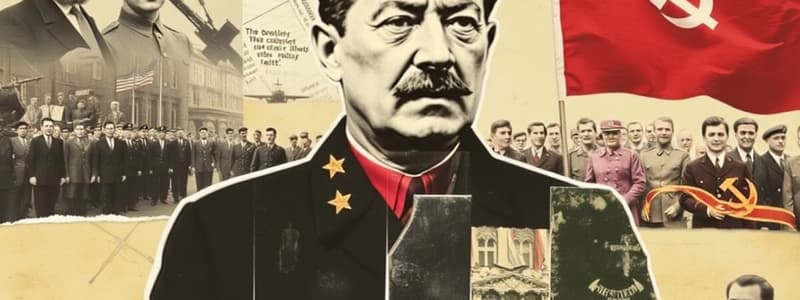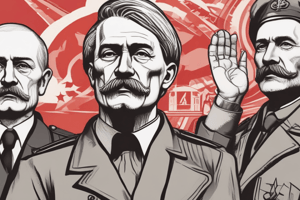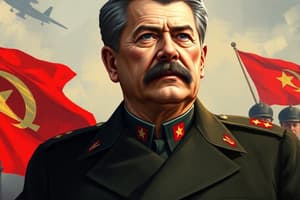Podcast
Questions and Answers
What was the main ideological difference between Trotsky and Stalin regarding revolution?
What was the main ideological difference between Trotsky and Stalin regarding revolution?
- Trotsky advocated for a permanent revolution. (correct)
- Stalin believed in a worldwide revolution.
- Trotsky supported socialism in one country.
- Stalin thought revolutions should fail outside Russia.
What was the role of the General Secretary during Stalin's rise to power?
What was the role of the General Secretary during Stalin's rise to power?
- To manage the Party’s ideological education.
- To oversee the Party's bureaucracy. (correct)
- To represent the Party in foreign relations.
- To lead the military operations of the Party.
What was the Triumvirate's significance during Stalin's rise?
What was the Triumvirate's significance during Stalin's rise?
- It was a group formed to oppose the New Economic Policy.
- It involved Stalin and rivals working in unison. (correct)
- It was a coalition that supported Trotsky's policies.
- It represented a stable leadership structure until 1927.
What strategy did Stalin employ to strengthen his position after Lenin's death?
What strategy did Stalin employ to strengthen his position after Lenin's death?
What action did Trotsky fail to take in 1924 that affected Stalin's rise?
What action did Trotsky fail to take in 1924 that affected Stalin's rise?
What was the stance of the 'Left' faction towards the New Economic Policy (NEP)?
What was the stance of the 'Left' faction towards the New Economic Policy (NEP)?
Which allies did Stalin build his personal following from during his rise to power?
Which allies did Stalin build his personal following from during his rise to power?
How did Stalin perceive the concept of 'Socialism in One Country'?
How did Stalin perceive the concept of 'Socialism in One Country'?
What was the name of the partnership formed by Stalin and Bukharin during 1926-1927?
What was the name of the partnership formed by Stalin and Bukharin during 1926-1927?
Why did Bukharin protest in April 1928 against the actions of officials?
Why did Bukharin protest in April 1928 against the actions of officials?
What was a significant result of the Fifteenth Party Congress in December 1927?
What was a significant result of the Fifteenth Party Congress in December 1927?
What strategy did Stalin employ to ensure loyalty among lower party members?
What strategy did Stalin employ to ensure loyalty among lower party members?
What does the term 'bureaucratic centralism' refer to in Stalin's governance style?
What does the term 'bureaucratic centralism' refer to in Stalin's governance style?
What was the outcome of the political struggles between Stalin and Bukharin by December 1929?
What was the outcome of the political struggles between Stalin and Bukharin by December 1929?
What was one of Stalin's key concerns in foreign policy regarding China?
What was one of Stalin's key concerns in foreign policy regarding China?
Which policy did Stalin implement in response to the food shortages in 1928?
Which policy did Stalin implement in response to the food shortages in 1928?
What was Stalin's attitude towards the Comintern during 1924-1929?
What was Stalin's attitude towards the Comintern during 1924-1929?
What stance did Stalin take regarding the relationship with Germany during the Treaty of Berlin?
What stance did Stalin take regarding the relationship with Germany during the Treaty of Berlin?
What did the term 'social fascists' refer to in Stalin’s policy during the Sixth Comintern Congress in 1928?
What did the term 'social fascists' refer to in Stalin’s policy during the Sixth Comintern Congress in 1928?
What was the significance of the term 'Literary Discussion' in the context of Stalin's rise to power?
What was the significance of the term 'Literary Discussion' in the context of Stalin's rise to power?
What ultimately happened to Bukharin's political position by November 1929?
What ultimately happened to Bukharin's political position by November 1929?
What drove the establishment of the Stalin cult during his leadership?
What drove the establishment of the Stalin cult during his leadership?
What was the role of fear in Stalin's government?
What was the role of fear in Stalin's government?
Flashcards
Permanent Revolution
Permanent Revolution
The idea that revolution should spread globally for success.
Socialism in One Country
Socialism in One Country
Stalin’s idea that socialism could succeed in Russia alone.
NEP
NEP
New Economic Policy allowing some private enterprise for recovery.
Trotsky's Exile
Trotsky's Exile
Signup and view all the flashcards
Stalin’s Role as General Secretary
Stalin’s Role as General Secretary
Signup and view all the flashcards
Ban on Factionalism
Ban on Factionalism
Signup and view all the flashcards
Triumvirate
Triumvirate
Signup and view all the flashcards
Bukharin's Alliance
Bukharin's Alliance
Signup and view all the flashcards
Fourteenth Party Congress
Fourteenth Party Congress
Signup and view all the flashcards
Left (United) Opposition
Left (United) Opposition
Signup and view all the flashcards
Duumvirate
Duumvirate
Signup and view all the flashcards
Literary Discussion
Literary Discussion
Signup and view all the flashcards
Trotsky's Expulsion
Trotsky's Expulsion
Signup and view all the flashcards
Bukharin's Downfall
Bukharin's Downfall
Signup and view all the flashcards
Bureaucratic Centralism
Bureaucratic Centralism
Signup and view all the flashcards
Cult of Personality
Cult of Personality
Signup and view all the flashcards
Chinese Communist Party
Chinese Communist Party
Signup and view all the flashcards
Treaty of Berlin
Treaty of Berlin
Signup and view all the flashcards
Comintern Transformation
Comintern Transformation
Signup and view all the flashcards
Great Turn
Great Turn
Signup and view all the flashcards
First Five Year Plan
First Five Year Plan
Signup and view all the flashcards
Collectivization
Collectivization
Signup and view all the flashcards
Fear as a Control Mechanism
Fear as a Control Mechanism
Signup and view all the flashcards
Study Notes
Stalin's Rise to Power (1924-1929)
- Ideological Debates: Key debates centered around "Permanent Revolution" versus "Socialism in One Country," NEP versus industrialization. Stalin initially wavered between "Left" and "Right" factions, before ultimately embracing rapid industrialization and agricultural collectivization.
- Stalin's 1924 Position: Stalin leveraged Lenin's funeral to enhance his position within the party leadership. He promoted Leninism, yet Trotsky's absence due to illness and perceived lack of opposition contributed to Stalin's rise. Stalin's role as General Secretary provided him control over the party bureaucracy.
- Defeat of the Left Opposition (1924-1927): Trotsky's failure to directly challenge Stalin, coupled with Stalin's support from others, led to a triumvirate-like power structure. Tensions within this group increased, with Stalin later forming an alliance with Bukharin ("Duumvirate"). This period also featured fierce intraparty conflicts, dubbed "Literary Discussion”, where political arguments were published widely. Ultimately, Trotsky, Zinoviev, and Kamenev were expelled from the party.
- Defeat of the Right (Bukharin) (1928-1929): Food shortages and Stalin's increasingly radical policies created conflict with Bukharin. Stalin's unilateral actions against peasants in Siberia, along with Bukharin's opposition, marked a critical turning point. Bukharin eventually lost his positions and was expelled from the Politburo, leading to Stalin's dictatorship by 1929.
- Consolidation of Power (1924-1929): Stalin established "bureaucratic centralism" as a core governing principle, using the concept of "factionalism" as a tool to silence opposition. He presented his rule as continuing Lenin's legacy while using divide-and-rule tactics, cultivating loyal supporters at lower party levels and thereby expanding his support. Fear and the secret police were key elements of his rule. He also established a cult of personality, portraying himself as the successor to Lenin.
Stalin's Foreign Policy (1924-1929)
- China: Stalin prioritized stability in Russia, supporting Jiang Jieshi of the Guomindang (GMD) over the Chinese Communist Party (CCP). This decision led to criticism from Trotsky.
- Germany: The Treaty of Berlin maintained cooperation, offering financial credits from German banks to the USSR.
- Comintern Changes: Stalin shifted the Comintern's focus to attacking European "social fascists." This signaled a radical new approach to foreign relations.
Economic Shift (1928-1929)
- Great Turn: This refers to the radical shift in economic policy towards rapid industrialization and agricultural collectivization.
- Five Year Plan: The first Five Year Plan marked the beginning of this era. This was a key component of the Great Turn policy shift.
Studying That Suits You
Use AI to generate personalized quizzes and flashcards to suit your learning preferences.




